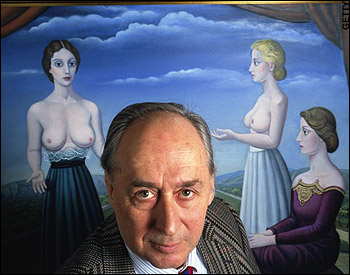Re/Search’s V. Vale Seeks Next Burroughs, Ballard, Lamantia… Ken Goldberg Interviews William Gibson
V. Vale, the great publisher of Re/Search, has sent out a very thoughtful essay wondering who is predicting the future as well as William S. Burroughs and J.G. Ballard did (particularly Ballard, I think) and calling everyone’s attention to an upcoming appearance by William Gibson in San Francisco.
EDITORIAL FROM V. VALE: “Mirror Mirror On the Wall, Who’s the Most Prophetic of Them All?”
It is difficult to survive and transcend the loss of one’s “father” [figures] — in my case there were three: William S. Burroughs, Philip Lamantia and J.G. Ballard. Philip was an authentic American Surrealist poet and first-generation “Beat” luminary — he read at that very first public reading of “Howl” at the Six Gallery at 3119 Fillmore Street/Filbert-Greenwich Sts, SF, Oct 7, 1955. Mr Lamantia was my first mentor. William S. Burroughs I didn’t meet until fall of 1978 when he came to San Francisco to read at the Keystone Korner in North Beach next to the Police Station. J.G. Ballard I corresponded with beginning in 1978 when I finally got an interview with him by proxy for my Search & Destroy #10 (incidentally, still available in a low-cost reprint from the original negatives). That same issue featured Burroughs on the cover; photo by Kamera Zie, who worked at City Lights, as I did.
When J.G. Ballard died April 19, 2009, I looked around and wondered who could replace him. He was a magnanimous, generous, spontaneous, unpretentious, publicity-avoiding ORIGINAL whose darkly imaginative literary output seemingly contradicted the ultra-polite, warmly humorous manner in which he treated people who visited him (including me). I was fortunate to be in his presence (and tape-record him) a number of times — in San Francisco, Berkeley, Palo Alto (?), and at Shepperton, outside London, near the Thames river where he took frequent après-lunch perambulations. By sheer luck I managed to tape-record both Burroughs and Ballard just months before they died…
Needless to say, nobody has yet “replaced” the above three deceased mentors. The nagging question is: Who are the people alive on the planet who are predicting the future as well as Burroughs and Ballard? The so-called CyberPunk writers (William Gibson, Bruce Sterling, Richard Kadrey, Rudy Rucker; who else?) are alive and penning miles of sentences — are they still the “zeitgeist” of now? Is there a zeitgeist of now, besides “Things Fall Apart” and –? Maybe we all need to attend the Extreme Futurist Festival…
We have long supported Survival Research Laboratories in their noisy machine performances divining a rusty, improvised-technological future in the perhaps money-less, state-less, more robotic- and drone-filled world landscape ahead of us. We’re reviewing the past 20 years, and an SRL associate comes to mind who has more or less selflessly curated dozens (maybe hundreds) of futuristic, bursting-with-ideas presentations by the crême-de-la-crême of cutting-edge thinkers, scientists and artists — most of them free; no admission charge — at U.C. Berkeley. That would be Ken Goldberg, who has been studying the future for several decades. Anyone heard of telerobotics? To quote, “Telerobotics is the field of robotics concerned with the remote distance control of robots using wireless connections, tethered connections, or internet connectivity via human input. Ken Goldberg, a pioneer of telerobotic art and his collaborative installation “Memento Mori” can be seen as the first telepresent, internet-based earthwork controlled by minute movements of the Hayward Fault in California and transmitted continuously as a seismic data stream to an embedded audio visual display.” [!]
To read this entire essay, go here.








